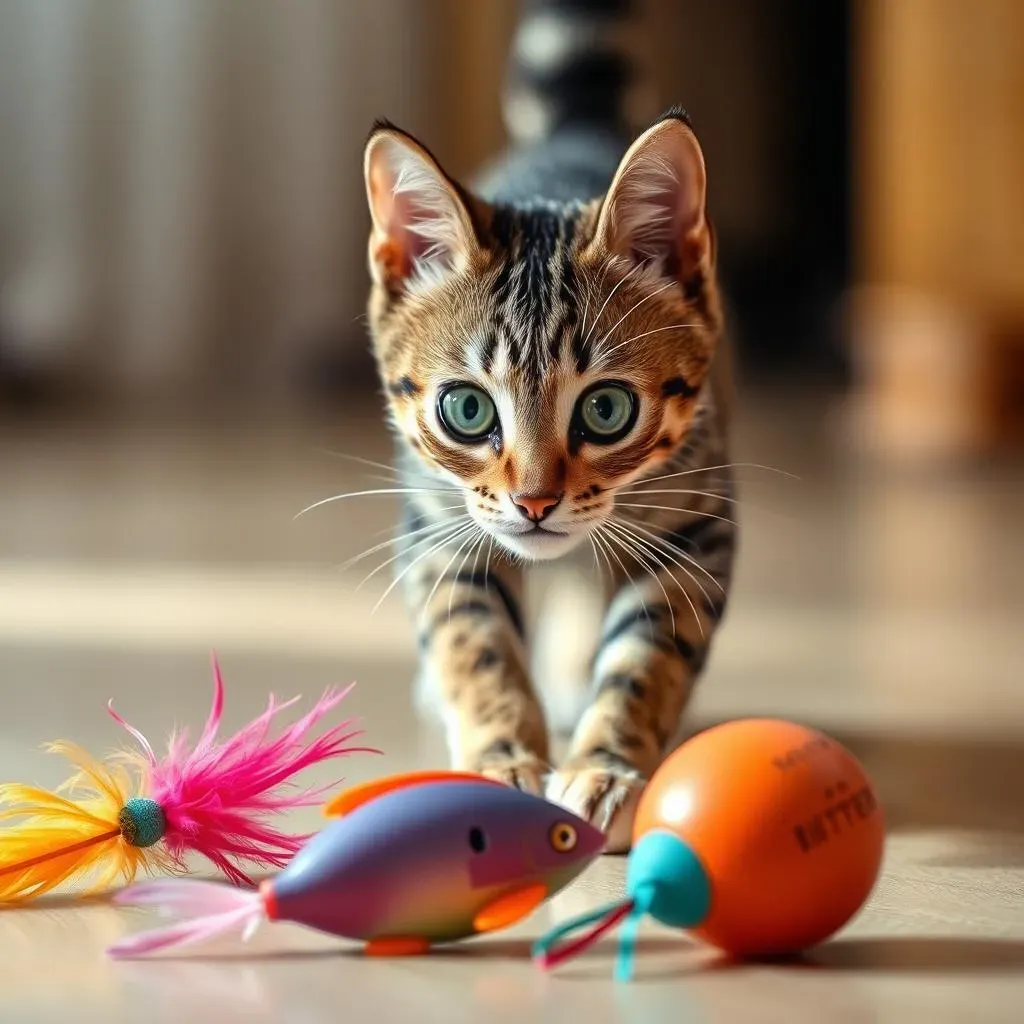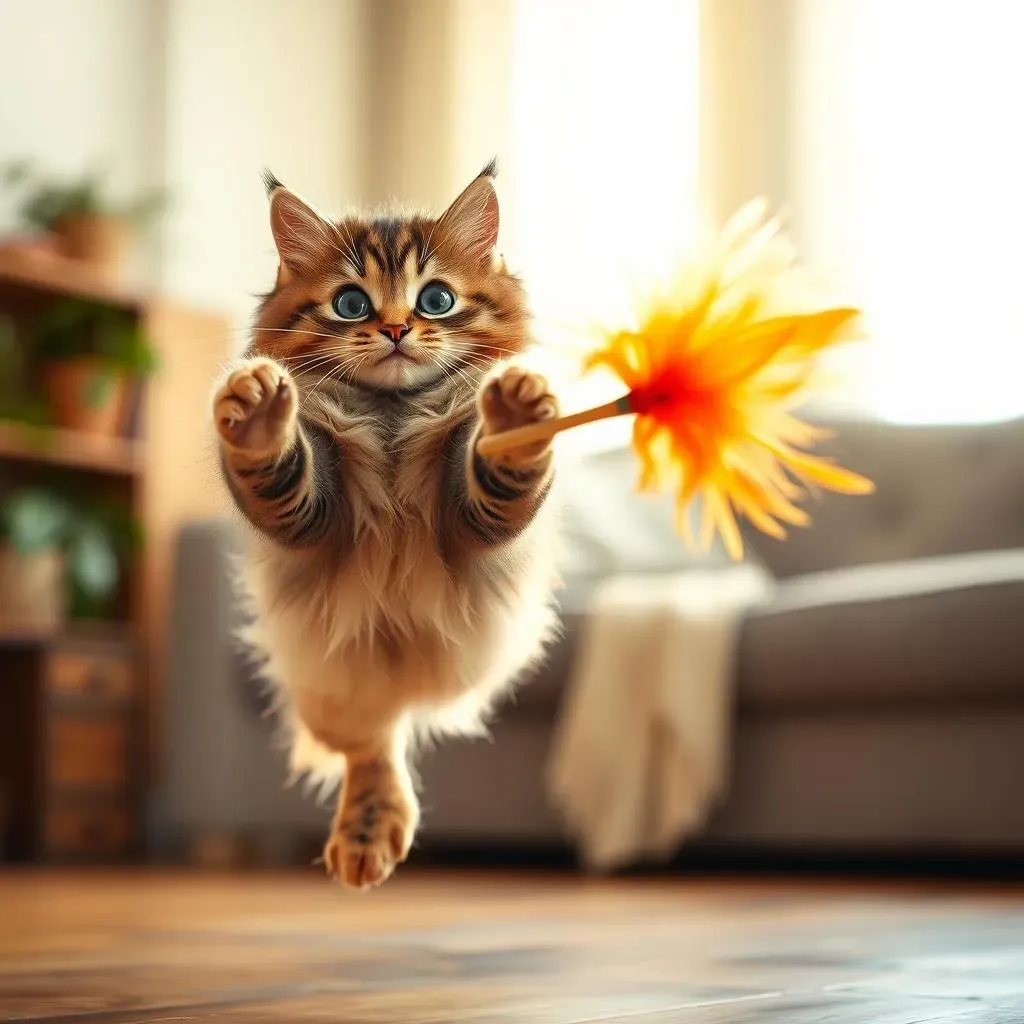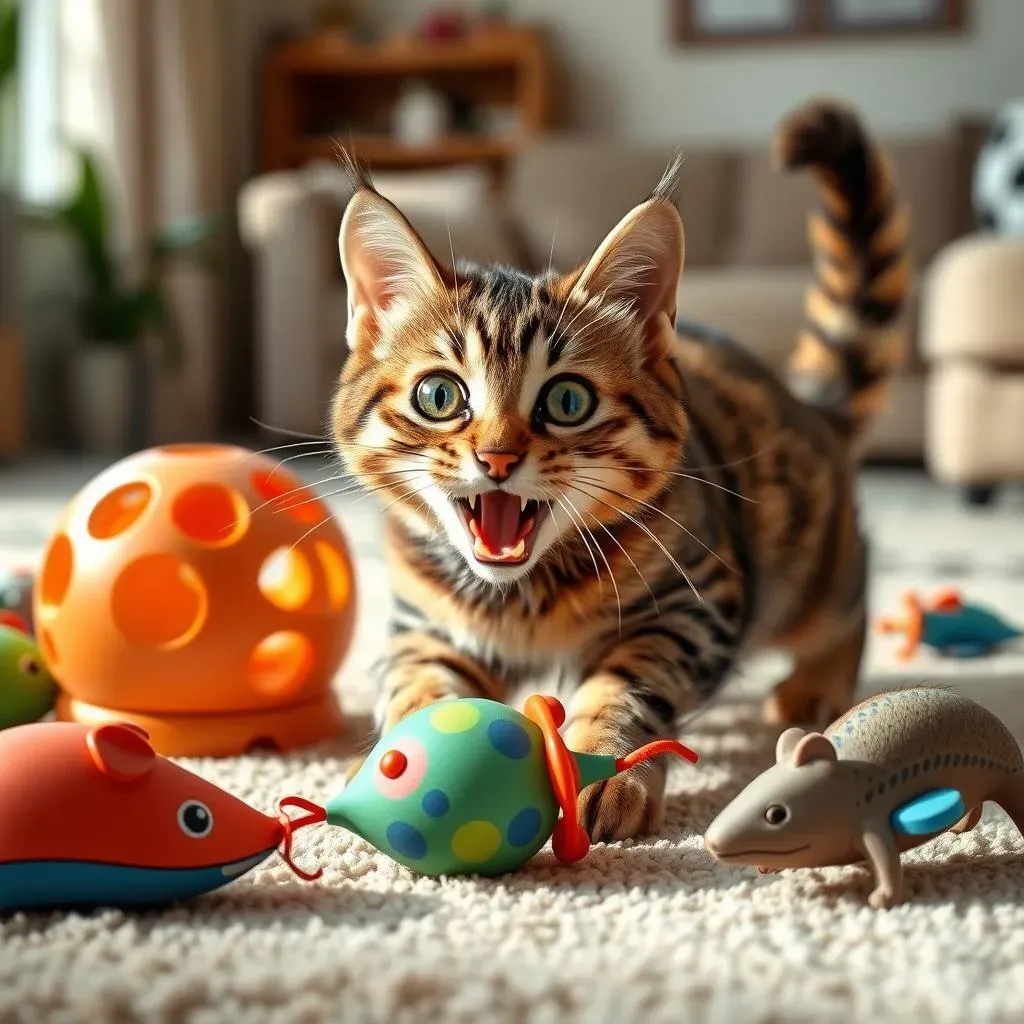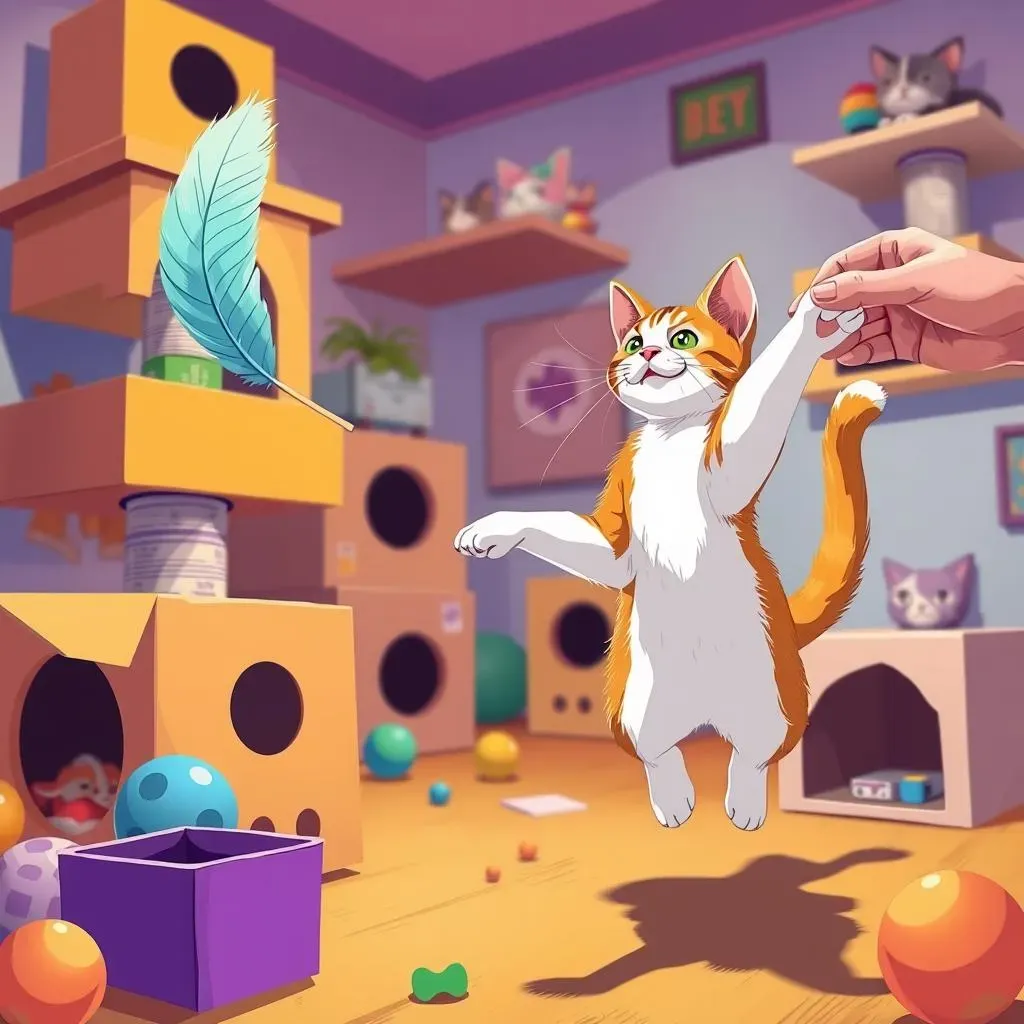Table of Contents
Does your feline friend stalk dust bunnies with the intensity of a lion on the Serengeti? Do they pounce on anything that moves, driven by an insatiable hunting instinct? If so, you're likely on the prowl for the best cat toys for cats that like to hunt. You've come to the right place. This isn't just about keeping your cat entertained; it's about tapping into their primal instincts, providing enrichment, and strengthening the bond between you and your furry predator.
Understanding Your Cat's Hunting Instincts and Toy Preferences

Understanding Your Cat's Hunting Instincts and Toy Preferences
Before diving headfirst into a mountain of cat toys, let's take a step back and consider what makes your cat tick. Understanding their hunting instincts is key to selecting toys they'll actually love. Cats aren't just furry freeloaders; they're highly skilled predators with a deeply ingrained need to hunt. Even if they're perfectly content with a bowl full of kibble, that instinct remains. That's why you see them stalking, chasing, and pouncing – it's in their DNA!
Think about it: in the wild, a cat spends a significant portion of its day hunting for food. This involves stalking, chasing, catching, and finally, the "kill." Our domesticated cats still crave this sequence, and providing them with appropriate outlets is crucial for their mental and physical well-being. A bored cat is often a destructive cat, so channeling that hunting drive into playtime can save your furniture and your sanity.
So, how do you figure out what kind of "prey" your cat prefers? Start by observing their existing play habits. What toys do they gravitate towards? Do they prefer toys they can bat around on the floor, or do they like to chase things that dangle? Do they enjoy wrestling and kicking toys, or are they more interested in puzzle toys that require them to "hunt" for treats?
Look for common threads in their preferred items. Is there a particular size, shape, or texture they seem to enjoy? Do they prefer toys that mimic the movement of birds, mice, or insects? Paying attention to these details will provide valuable clues when choosing new toys. If your cat is obsessed with feathers, a bird-like wand toy might be a surefire hit. If they love batting around small balls, a collection of colorful pom-poms could be the answer.
Don't be afraid to experiment! Every cat is an individual, and what works for one might not work for another. Keep a variety of toys on hand and rotate them regularly to keep things interesting. This prevents your cat from becoming bored and ensures that playtime remains a stimulating and enriching experience. Understanding your cat's unique hunting style and preferences is the first step to finding the best cat toys to satisfy their inner predator.
Observation | Possible Preference | Toy Suggestion |
|---|---|---|
Loves to chase laser pointer | Fast-moving prey | Wand toy with feathers or a fast-moving lure |
Enjoys batting small objects | Small, easily manipulated prey | Small balls, pom-poms, or toy mice |
Likes to kick and bunny-kick | Larger prey to wrestle with | Kicker toy filled with catnip |
The Ultimate Guide to Wand Toys: Simulating the Thrill of the Hunt

The Ultimate Guide to Wand Toys: Simulating the Thrill of the Hunt
Why Wand Toys Reign Supreme
let's talk wand toys. Seriously, if you could only have one type of toy for your cat, make it a wand toy. These things are pure magic. Why? Because they perfectly mimic the movement of prey, triggering your cat's hunting instincts in a way that few other toys can. Think about it: a bird flitting through the air, a mouse scurrying across the floor, a bug darting erratically – that's what a good wand toy recreates.
The key is in the interaction. Unlike static toys that your cat might eventually ignore, wand toys require you to be involved, actively engaging your cat in a simulated hunt. This not only provides physical exercise but also mental stimulation, keeping them sharp and preventing boredom. Plus, it's just plain fun! Watching your cat stalk, chase, and pounce on that feathered lure is guaranteed to bring a smile to your face.
Mastering the Art of the Tease
But simply waving a wand toy around isn't enough. You need to *become* the prey. Think about how a real mouse or bird would move. Erratic, unpredictable, and always trying to escape. Don't just dangle the toy in front of your cat's face – make it dart, weave, and hide behind objects. Let your cat stalk and plan their attack. The more realistic you can make the movement, the more engaged your cat will be.
Also, remember the "hunt, catch, kill" sequence. After a period of intense chasing and stalking, allow your cat to "catch" the toy. Let them grab it, bite it, and bunny-kick it to their heart's content. This is the culmination of the hunt, and it's crucial for satisfying their predatory instincts. Once they've had their fill, take the toy away and start the process again. This keeps them wanting more and prevents them from getting bored.
- Vary the speed: Alternate between slow, deliberate movements and quick, erratic bursts.
- Use the environment: Incorporate furniture and other objects to create obstacles and hiding places.
- End on a high note: Always finish the play session with a successful "catch" to leave your cat feeling satisfied.
Beyond Wands: Exploring Other Engaging Cat Toys for Hunting Cats

Beyond Wands: Exploring Other Engaging Cat Toys for Hunting Cats
so wand toys are amazing, but even the most dedicated hunter needs variety! Think of it like this: would you want to eat the same meal every single day? Probably not. The same goes for your cat. That’s where exploring other engaging cat toys comes in. While wands excel at interactive play, there's a whole world of toys designed for solo hunting sessions, catering to different aspects of the predatory sequence.
We're talking about toys that stimulate their minds, challenge their problem-solving skills, and allow them to indulge their natural instincts, even when you're not around to wield the wand. From puzzle feeders that mimic the challenge of finding food to kicker toys that let them grapple and "kill" their prey, the options are endless. The key is to find a mix of toys that keeps them entertained, engaged, and most importantly, satisfied.
Puzzle Feeders: The Thinking Cat's Toy
Let’s kick things off with puzzle feeders. These are seriously genius. Instead of just plopping down a bowl of kibble, puzzle feeders require your cat to work for their food. They have to bat, paw, and manipulate the toy to release the tasty treats inside. This taps into their natural hunting instincts by making them "hunt" for their meal, providing mental stimulation and preventing boredom.
There are tons of different puzzle feeder designs out there, from simple balls with holes to more complex contraptions that require your cat to solve a series of challenges. Start with something easy and gradually increase the difficulty as your cat gets the hang of it. Not only does this keep them entertained, but it can also help slow down fast eaters and prevent digestive issues. It's a win-win!
- Start simple: Choose a puzzle feeder with an easy-to-solve mechanism.
- Use high-value treats: Entice your cat with their favorite snacks.
- Supervise playtime: Make sure your cat doesn't get frustrated or give up.
Kicker Toys: Unleash the Inner Wrestler
Next up, we have kicker toys. These are long, plush toys that cats can grab onto with their front paws and kick with their back legs – hence the name. They're perfect for cats who love to wrestle and bunny-kick their prey. Kicker toys provide a satisfying outlet for their pent-up energy and allow them to fully express their predatory instincts.
Look for kicker toys that are made from durable materials and filled with catnip to really get your cat going. The size is also important – choose a toy that's long enough for your cat to comfortably wrap their paws around and kick with their hind legs. Some kicker toys even have crinkly material inside for added sensory stimulation. Just be prepared for some serious wrestling action!
Toy Type | Benefits | Considerations |
|---|---|---|
Puzzle Feeders | Mental stimulation, prevents boredom, slows down eating | Start with easy designs, use high-value treats |
Kicker Toys | Physical exercise, satisfies wrestling instincts, catnip-infused | Choose durable materials, appropriate size |
Catnip Mice | Classic hunting simulation, encourages chasing and pouncing | Replace regularly to maintain potency |
Mastering the Art of Play: How to Keep Your Cat Engaged and Satisfied

Mastering the Art of Play: How to Keep Your Cat Engaged and Satisfied
The Importance of Play Variety
Alright, so you've got the toys, but are you *really* playing with your cat? Mastering the art of play is about more than just dangling a toy and hoping for the best. It's about understanding your cat's individual play style, providing variety, and creating an engaging and stimulating experience that satisfies their hunting instincts. Remember, a bored cat is a mischievous cat, so investing in playtime is an investment in your sanity (and your furniture!).
Think of playtime as a conversation with your cat. You're responding to their cues, adjusting your approach, and creating a dynamic interaction that keeps them on their toes. Are they a high-energy hunter who loves a fast-paced chase? Or are they a more deliberate stalker who prefers a slow and strategic approach? Tailoring your play style to their preferences is key to keeping them engaged and satisfied.
Creating a Stimulating Play Environment
The environment matters just as much as the toys themselves. A cluttered, boring space isn't exactly conducive to an exciting hunt. Create a stimulating play environment by incorporating vertical spaces, hiding places, and obstacles that your cat can explore. Cat trees, shelves, and even cardboard boxes can transform your home into a feline playground.
Also, consider rotating your cat's toys regularly to keep things fresh and exciting. Just like us, cats can get bored with the same old routine. By introducing new toys and hiding away old favorites, you can reignite their interest and keep them engaged in playtime. Think of it as a treasure hunt for your feline friend!
- Vertical spaces: Cat trees, shelves, and window perches.
- Hiding places: Cardboard boxes, tunnels, and blankets.
- Rotating toys: Keep things fresh by introducing new toys regularly.
Rotating and Refreshing: Keeping Your Cat's Hunting Instincts Sharp with the Best Cat Toys

Rotating and Refreshing: Keeping Your Cat's Hunting Instincts Sharp with the Best Cat Toys
The Weekly Toy Rotation: Banishing Boredom
let's talk about a game-changer: the weekly toy rotation. This is the secret weapon for keeping your cat engaged and preventing toy fatigue. Think of it as curating a mini-museum of prey for your feline friend. By swapping out their toys on a regular basis, you're essentially creating a "new" hunting environment each week, reigniting their curiosity and stimulating their predatory instincts.
The concept is simple: gather all of your cat's toys (yes, even the ones they seem to have forgotten about) and divide them into smaller groups. Each week, you'll present your cat with a different group of toys, keeping the rest hidden away. This makes each toy feel fresh and exciting, as if they've never seen it before. It's like Christmas morning, but every week!
The Art of the Refresh: Keeping Toys Enticing
But rotation isn't the only trick up our sleeves. Just like a chef refreshes their ingredients, we need to revitalize our cat's toys to keep them appealing. A worn-out, slobber-covered toy mouse isn't exactly going to trigger the hunting instinct. That's where cleaning, repairing, and even "catnip-izing" come into play. Regularly washing fabric toys, replacing worn-out feathers, and adding a sprinkle of fresh catnip can work wonders.
Think of it as a spa day for your cat's toys. A little TLC can go a long way in making them more enticing and stimulating. And if a toy is truly beyond repair, don't be afraid to retire it. A new toy, even a simple one, can be a welcome addition to the rotation and provide a fresh source of excitement for your feline hunter. After all, variety is the spice of life – even for cats!
Strategy | Description | Benefits |
|---|---|---|
Weekly Rotation | Swapping out toy groups weekly | Prevents boredom, reignites curiosity |
Toy Refresh | Cleaning, repairing, and catnip-izing | Keeps toys appealing, stimulates senses |
Strategic Replacement | Retiring worn-out toys, introducing new ones | Provides fresh excitement, caters to evolving preferences |
Conclusion: Happy Hunting, Happy Cat!
Finding the best cat toys for cats that like to hunt is an ongoing adventure. By understanding your cat's individual preferences, tapping into their natural hunting instincts, and mastering the art of interactive play, you can create a stimulating and fulfilling environment that keeps them happy, healthy, and engaged. Remember to rotate toys regularly, prioritize safety, and most importantly, have fun! A well-stimulated cat is a happy cat, and a happy cat makes for a happy home.